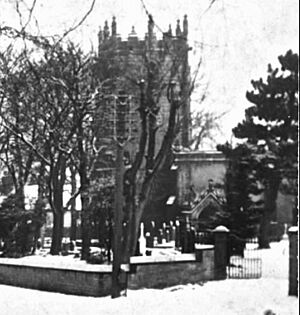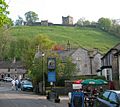Castleton, Derbyshire facts for kids
Quick facts for kids Castleton |
|
|---|---|
 Castleton |
|
| Population | 649 2001 UK census |
| OS grid reference | SK1583 |
| Civil parish |
|
| District |
|
| Shire county | |
| Region | |
| Country | England |
| Sovereign state | United Kingdom |
| Post town | HOPE VALLEY |
| Postcode district | S33 |
| Dialling code | 01433 |
| Police | Derbyshire |
| Fire | Derbyshire |
| Ambulance | East Midlands |
| EU Parliament | East Midlands |
| UK Parliament |
|
Castleton is a lovely village in Derbyshire, England. It's found in the High Peak area, right at the end of the Hope Valley. The village sits by the Peakshole Water, which is a small river that flows into the River Noe.
Castleton is special because it's located between two very different types of landscapes. To the north, you have the rugged Dark Peak with its rough gritstone hills. To the south, there's the gentler White Peak with its smooth limestone scenery. In 2011, about 642 people lived here.
Contents
A Look Back in Time

Castleton is a very old village. It was even mentioned in a famous old book called the Domesday Book in 1086. Back then, it was called Pechesers. The book said that two people, Arnbiorn and Hundingr, owned land here. This land was part of the castle properties belonging to a powerful person named William Peverel.
The village has a beautiful church called St Edmund's. It was built in the Norman style, which means it's very old. The church was fixed up around 1837. It has old windows from the late 1200s and a tall tower. Inside, you can see old wooden seats called box pews, some of which date back to the 1660s.
Long ago, there was a hospital for sick people in Castleton. It was called the Hospital of Saint Mary in the Peak. Experts from the University of Sheffield are still looking into the history of this hospital and the old town that was built near Peveril Castle. They've found old documents from the 1300s that talk about the area. You can still see parts of the village's old defenses from the Middle Ages, which are now protected as a Scheduled monument.
Castleton has a long history of lead mining. The Odin Mine, located about 1.5 kilometers (1 mile) west of the village, is one of the oldest lead mines in the whole country. Mining was so big here that it even affected the air! Scientists studying ice from a glacier in Switzerland found that lead pollution in Europe between 1170 and 1216 was as high as during the Industrial Revolution. Much of this pollution came from mines in the Peak District, like those near Castleton.
The mining work helped create and make bigger the amazing caves you can visit today. There are four famous "show caves" near Castleton: Peak Cavern, Blue John Cavern, Speedwell Cavern, and Treak Cliff Cavern. You can even find a special, rare stone called Blue John here. It's still mined in small amounts and sold in local shops. One of these shops is in a very old building from the 1600s, which used to be a tollhouse.
Since the 1920s, the main industry in the area has been making cement. The Hope Cement Works is close by, and its quarry, where they get materials, is near Castleton. In the village market place, there's a war memorial to remember the local people who died in the World Wars.
Exploring Castleton's Surroundings
Castleton is surrounded by hills on three sides. To the north, there's a big ridge called Great Ridge. It stretches from Mam Tor to Back Tor and Lose Hill. There's a special spot on the ridge called Hollins Cross where many paths meet. From here, you can enjoy amazing views and even walk over to Edale. A famous explorer named Alexander von Humboldt visited the caves near Castleton in 1790 to study the rocks and land.
Castleton used to be on a main road, the A625. This road went over Mam Tor, which is sometimes called the "Shivering Mountain" because its ground is very loose and often slides. After many landslides, the road over Mam Tor had to be closed. Now, the only way to leave Castleton heading west is a narrow, winding road called Winnats Pass. This road is steep and not good for big trucks, so most traffic uses the eastern road (A6187) towards Hope and Sheffield.
Castleton has a small bus station. You can catch buses to Sheffield and also to places like Tideswell and Bakewell. While there isn't a train station right in Castleton, the Hope station is only about 3 kilometers (2 miles) away. If you have a train ticket to Hope or Edale, you can use it on the connecting buses to Castleton.
Learning in Castleton
Castleton has its own school, Castleton Church of England Primary School. It was rated as 'good' in 2017. The school and the area around it were even shown in a short film clip used by Channel 4 in 2017! For older students, the nearest secondary school is Hope Valley College.
Fun Things to Do in Castleton
Castleton is a very popular place for tourists. There are lots of pubs, tea shops, and guest houses where visitors can stay. You'll also find a big car park, a Visitor Centre with a museum about Castleton's history, and shops selling outdoor gear. There's even a youth hostel for travelers. Many schools visit the area for field trips and studies.
It's a fantastic place for walking! You can explore paths up Cave Dale, Winnats Pass, Mam Tor, and Hollins Cross. The four "show caves" are a big draw: Blue John Cavern, Peak Cavern, Treak Cliff Cavern, and Speedwell Cavern. Speedwell Cavern even has an underground boat ride! At least one of these caves is open all year. Castleton also has a post office combined with a general shop.
A special event in Castleton is Castleton Garland Day, celebrated on May 29th. On this day, a person called the Garland King walks through the streets wearing a huge garland of flowers. Local girls dressed in white with flowers follow him.
Walkers love Castleton because there are so many public footpaths. You can take easy walks along the river to nearby villages like Hope and Bamford. Or, if you're up for a challenge, you can hike up onto the Great Ridge for amazing views before heading down to Edale or back to Castleton. A longer walking trail called the Limestone Way starts in Castleton and goes south through Cave Dale.
Famous People from Castleton
- Isaac Ambrose: A writer and church leader who lived here in 1627.
- William Dawkins: He found important old fossils near Castleton.
- Charles Roe: An important industrialist, born here in 1715.
- Drenge: A two-person blues rock band.
- Debbie Rush: An actress known for Coronation Street.
- Randolph Douglas: He started a museum called 'House of Wonders', which is now closed.
- Samuel Bagshawe: A soldier and politician who lived at Goosehill Hall.
Castleton in Stories and Movies
Castleton has appeared in TV shows and movies!
- The village was featured in an episode of Most Haunted: Midsummer Murders. The show explored an old murder from the 1700s, and much of it took place in Speedwell Cavern.
- The local caves were used as a filming location for the underworld in the 1990 BBC TV show The Silver Chair. This show was based on one of the Narnia books by C.S. Lewis.
- Cave Dale can be seen in the movies The Princess Bride (1987) and The Other Boleyn Girl (2008).
- The town is also mentioned briefly in a play called The Devil is an Ass by Ben Jonson, first performed in 1616.
Images for kids
-
Looking west, Mam Tor towers above the main street of Castleton
-
Panoramic view of Castleton from Peveril castle
See also
 In Spanish: Castleton (Derbyshire) para niños
In Spanish: Castleton (Derbyshire) para niños














